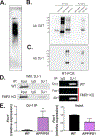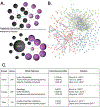DJ-1-mediated repression of the RNA-binding protein FMRP is predicted to impact known Alzheimer's disease-related protein networks
- PMID: 39610285
- PMCID: PMC12444778
- DOI: 10.1177/13872877241291175
DJ-1-mediated repression of the RNA-binding protein FMRP is predicted to impact known Alzheimer's disease-related protein networks
Abstract
Background: RNA-binding proteins (RBPs) modulate the synaptic proteome and are instrumental in maintaining synaptic homeostasis. Moreover, aberrant expression of an RBP in a disease state would have deleterious downstream effects on synaptic function. While many underlying mechanisms of synaptic dysfunction in Alzheimer's disease (AD) have been proposed, the contribution of RBPs has been relatively unexplored.
Objective: To investigate alterations in RBP-messenger RNA (mRNA) interactions in AD, and its overall impact on the disease-related proteome.
Methods: We first utilized RNA-immunoprecipitation to investigate interactions between RBP, DJ-1 (Parkinson's Disease protein 7) and target mRNAs in controls and AD. Surface Sensing of Translation - Proximity Ligation Assay (SUnSET-PLA) and western blotting additionally quantified alterations in mRNA translation and protein expression of DJ-1 targets. Finally, we utilized an unbiased bioinformatic approach that connects AD-related pathways to two RBPs, DJ-1 and FMRP (Fragile X messenger ribonucleoprotein 1).
Results: We find that oligomeric DJ-1 in AD donor synapses were less dynamic in their ability to bind and unbind mRNA compared to synapses from cognitively unimpaired, neuropathologically-verified controls. Furthermore, we find that DJ-1 associates with the mRNA coding for FMRP, Fmr1, leading to its reduced synaptic expression in AD. Through the construction of protein-protein interaction networks, aberrant expression of DJ-1 and FMRP are predicted to lead to the upregulation of key AD-related pathways, such as thyroid hormone stimulating pathway, autophagy, and ubiquitin mediated proteolysis.
Conclusions: DJ-1 and FMRP are novel targets that may restore established neurobiological mechanisms underlying AD.
Keywords: Alzheimer's disease; DJ-1; KEGG pathways; RNA networks; RNA-binding proteins; autophagy; fragile x messenger ribonucleoprotein (FMRP); synapse; thyroid hormone stimulating pathway; ubiquitin mediated proteolysis.
Conflict of interest statement
Declaration of conflicting interestsThe authors declared no potential conflicts of interest with respect to the research, authorship, and/or publication of this article.
Figures





References
-
- Morris AR, Mukherjee N and Keene JD. Systematic analysis of posttranscriptional gene expression. Wiley Interdisciplinary Reviews: Systems Biology and Medicine 2010; 2: 162–180. - PubMed
-
- Keene JD and Lager PJ. Post-transcriptional operons and regulons co-ordinating gene expression. Chromosome research 2005; 13: 327–337. - PubMed
MeSH terms
Substances
Grants and funding
LinkOut - more resources
Full Text Sources
Medical
Molecular Biology Databases
Miscellaneous

